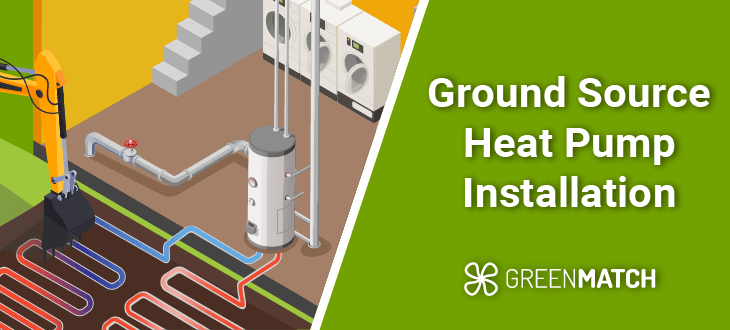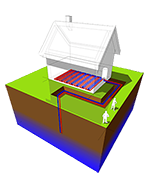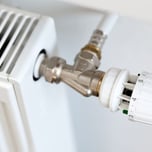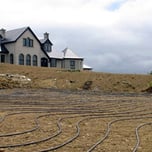
Get up to 4 quotes by filling in only 1 quick form

Slash your energy bills by installing a heat pump

We’ve helped over 500,000 homeowners reduce their carbon footprint
- GreenMatch
- Ground Source Heat Pumps
- Ground Source Heat Pump Installation
Ground Source Heat Pump Installation

Ground source heat pumps (GSHPs) are a type of renewable heating and cooling system that is able to extract the heat from the ground to heat up a building or even meet its hot water demands. This is done thanks to the constant temperature of the ground, which provides heat all year long without the need to burn fossil fuels, becoming an excellent energy-efficient, cost-effective and sustainable heating option for your home.
By opting for ground source heat pump installation, you can generate up to four times as much heat as the electrical energy used to power the compressor and circulation pumps within the system.
This aspect of heat pumps, specifically ground source heat pumps, makes them one of the most reliable and environmentally friendly renewable heat energy solutions out there. Additionally, ground source heat pump prices, when compared to their renewable energy cousins, also tend to produce some of the highest cost-savings in the long run. In terms of installation as well, the process itself is not particularly arduous either.
The main benefits of a ground source heat pump installation are summarised below:
- Use of a renewable source of energy
- Operational cost savings of up to 50% in heating bills means initial capital investment is paid back quickly
- Heat Pump Grants and incentives from the UK government (BUS)
- An invisible heating system with low noise levels
- Due to their automated nature, ground source heat pumps have relatively low maintenance requirements alongside low running costs
With all these advantages, the following question may still come to mind: Why install a ground source heat pump? In this article, we have elaborated a comprehensive guide on everything there is to know about the installation of ground source heat pumps.
If you’re already convinced by the benefits and want to get a ground source heat pump installed as soon as possible, then let GreenMatch help you. Going through the hassle of finding and contacting different installers can be frustrating and take up hours of your free time. But it doesn’t have to be that way. At GreenMatch we have a network of qualified heat pump installers who we can easily connect you with, so you can spend your free time doing things you enjoy.
Get free quotes on ground source heat pump installations today by filling in our short contact form. It will take no more than a minute and we will provide you with up to 3 free, no-obligation quotes from our top suppliers in the UK. Click the button below to begin.
- Quotes from local engineers
- Payment by finance available
- Save up to £1100 per year
It only takes 30 seconds



Is a Ground Source Heat Pump Suitable for Your Home?
If you are a homeowner currently considering a ground source heat pump installation, there are a number of factors to consider. These initial considerations can go a long way towards ensuring your ground source heat pump installation process goes as smoothly and efficiently as possible:
- Do you have enough space in your backyard/garden for a horizontal array? Or would you need a borehole installation?
- Is your home currently well-insulated? If your home has a higher heat demand, you will likely require a larger system, which is more expensive to purchase, install, and run. It is recommended that if you are considering having a ground source heat pump installed that you first insulate your home to the highest possible degree.
- What kind of heating system does your home currently have? Since ground source heat pumps produce relatively low-temperature heat, underfloor heating is the most ideal choice of emitter to work in conjunction with such a heating system.
The video below explains how a ground source heat pump works:

Ground Source Heat Pump Installation Costs
Ground source heat pump installation costs typically range between £13,000 – £35,000. Given that the performance of ground source heat pumps is such that, if properly designed and implemented, can represent an extremely efficient and cost-saving form of heating for UK household, hiring a qualified and well-experienced contractor is imperative.
Prospective homeowners should try not to be immediately put off by the upfront capital cost of a ground source heat pump installation. As with all things that produce long-term cost savings, ground source heat pumps too require a relatively substantial upfront investment.
The overall cost of your ground source heat pump installation will predominantly depend on whether you opt for a horizontal ground loop, or a vertical borehole system. This is a decision that you will have to make based on your ground conditions and how much space you have available.
Generally speaking, a well-insulated home will need a smaller ground source heat pump installation with small ground loops, which therefore will be less expensive compared to a ground source heat pump installation in a lesser-insulated home.
There is a significant difference in groundwork costs between horizontal and vertical ground loop systems as can be seen below:
| Number of Rooms | Heat Pump Capacity | Heat Pump and Installation Cost | Horizontal Groundwork Cost | Vertical Groundwork Cost |
|---|---|---|---|---|
| 1-2 | 4kW | £11,000+ | £3,000 | £6,000 |
| 3-4 | 8kW | £16,000+ | 5,000 | £13,000 |
| 5-6 | 12kW | £20,000+ | £8,000 | £20,000 |
These cost figures do not represent actual offers and are merely for general reference purposes. Exact costs will depend on your individual case requirements and your best bet would be to consult with and gather quotes from a number of different heat pump brands so that you can become better acquainted with not only the costs associated with a ground source heat pump installation project, but also the requirements of running and installing one.
Thankfully, GreenMatch can help you with just that. We can quickly connect you with up to 3 qualified heat pump installers available in your area. This way, you can easily compare their quotes and choose the best deal. Click the button below to get your free, non-binding quotes now.
- Quotes from local engineers
- Payment by finance available
- Save up to £1100 per year
It only takes 30 seconds



6-Step Guide to Ground Source Heat Pump Installation

The fact that ground source heat pumps work by extracting solar energy stored in the ground means they can be installed virtually anywhere. The typical ground source heat pump system is generally made up of four basic components – the ground loop (which collects heat from the ground), the heat pump (which raises the heat to an appropriate temperature and transfers the resulting heat to the home), the heat distribution system, and the hot water heater.
Ground source heat pumps can have either open loop or closed loop systems buried underground. While the open loop system requires access to ponds or some body of water, closed loop systems do not. The following breakdown should help with understanding the differences.
| Characteristics | Open Loop System | Closed Vertical Loop System | Closed Horizontal Loop System |
|---|---|---|---|
| How it works | Water is extracted from the ground and returned to an aquifer | Underground vertical pipes circulate heat exchange fluid in boreholes | Underground horizontal pipes laid in trenches circulate heat exchange fluid |
| Drawback | Output depends on the amount of water that can be extracted | Special equipment is needed for drilling the boreholes, which also makes it more expensive | Large area of land needed – much larger than vertical systems |
| Energy efficiency | More efficient than closed loop systems | Less efficient than open loop systems (therefore more boreholes required) | Less efficient than open loop systems |
| Cost efficiency | More efficient than closed loop systems | Less cost-efficient than open loop systems | Less cost-efficient than open loop systems |
Ground source heat pumps are one of the most cost-efficient renewable energy systems, and their installation process is not extremely difficult, either. However, there are some obstacles that can make or break your energy efficiency ambitions with a ground source heat pump installation.
Therefore, the following steps explain ground source heat pump installation:
1. Assess Your Home
Perhaps the most important first step in the design of a ground source heat pump is adequate planning and preparation.
Have an installer visit your home and appraise exactly what type of heat pump, energy supply source, and energy distribution would be the best fit. The installer will also evaluate your domestic hot water requirements, existing exchanger and heating systems, current level of insulation in the home, as well as the geology and hydrology of the soil in your land.
Only after gathering all this information, would your installer be able to draw up a building heat load analysis and plan a well-designed ground source heat pump system for your home.
2. Excavate Loop Fields
Thereafter, your contractors will perform the excavation of horizontal or vertical loop fields so that later on pipes can be buried in the soil. The excavation process takes about one to two days, on average.
A key consideration in installing a ground source heat pump is the location and design of the loop. Horizontal loop systems are generally the most cost-efficient and involve the excavation of shallow trenches in which polyethylene pipes can be laid at depths of between 1m to 2m. Although horizontal installations are cheaper, they do require a minimum of ½ an acre of land.

In cases where space is limited, an alternative to horizontal loop systems are vertical loop systems. Here, boreholes are dug using drilling rigs to depths of anywhere between 15m and 122m where pipes are then buried into them. These systems tend to be a little pricier to implement, but since ground temperatures are more stable the deeper the loop is located, the heat collection efficiency is also considerably higher.

3. Install the Pipes
The contractor will then install the pipes in the buried loop fields, which will later be filled with a mixture of water and antifreeze solution that will act as a heat exchanger.
4. Modify the Heat Distribution Infrastructure
Then, your contractor will modify the ductwork and, if necessary, replace your old heat distribution infrastructure with a newer one. Ideally, this will be underfloor heating as this usually works best in conjunction with ground source heat pumps. For a one-man team, this can take up to three to four days to complete.
5. Install the Heat Pump
Lastly, your installer will connect the heat pump to the ductwork, the ground loop, and possibly the new in-floor heating system. Before turning on the heat pump for the first time, it is important to observe the following: water flow from the ground exchange loop, air temperatures, and amp draw on the heat pump.
6. Maintain the Heat Pump in Good Condition
The good news is that because ground source heat pumps have very few moving parts, usually very little can go wrong. Having said that, it is your responsibility to make sure that the heat pump is in good condition for as long as possible. Remember to perform seasonal adjustments to ensure that your heat pump operates as efficiently as possible during both heating and cooling periods.
Measuring the Performance of Ground Source Heat Pumps
The heat output (kW) in relation to the electrical input (kW) is known as the “coefficient of performance” (CoP). Typically, a ground source heat pump has a CoP of 4, which in broad terms means that for every 1kW of electricity used to drive the heat pump, 4kW of heat is produced for space heating and domestic hot water.
For instance, a 200m² house that uses 11,000 kWh of energy for heating purposes and another 4,000 kWh for domestic hot water will need (11,000 + 4,000) / 4 = 3,750 kWh of electricity to run a ground source heat pump with a CoP of 4.
Renewable Heat Incentive for Ground Source Heat Pumps
As with owners of biomass boilers, air source heat pumps, and other renewable heat technologies heat, owners of ground source heat pumps can apply for Renewable Heat Incentive (RHI), which is a government financial scheme aimed to incentivise homeowners to transition to renewable heat technologies. It was developed by The Department for Business, Energy & Industrial Strategy (BEIS) and will support new renewable heat projects until March 2021.
After this date, new ground source heat pump installations may not receive any form of subsidy, which is why now is a great time to invest in ground source heat pumps and take advantage of the subsidy regime while the RHI budget lasts.
Below is a table of subsidy tariffs homeowners can expect to receive back in cashback taken from Ofgem, the government regulator for electricity and natural gas markets in the UK. These payments are made on a quarterly basis over seven years from the date of commissioning.
| Applications submitted | 09/04/14 – 31/03/15 | 01/04/15 – 31/03/16 | 01/04/16 – 31/03/17 | 01/04/17 – 31/12/17 | 01/01/18 – 31/03/18 | 01/04/18 – 30/09/18 |
|---|---|---|---|---|---|---|
| Ground source heat pumps (p / kWh) | 18.80p | 19.10p | 19.33p | 19.64p | 19.86p | 20.46p |
Choosing the Right Installer for Your Home
As mentioned earlier, a lot of factors that must be taken into consideration before arriving at the overall design of a ground source heat pump installation project and its subsequent total cost calculation. In light of this, choosing the right (i.e. well-experienced as well as qualified) ground source heat pump installer is crucial. Although this can sometimes seem like quite the daunting task, it does not have to be. Your initial concerns should surround the following:
- How trustworthy, qualified, and experienced your ground source heat pump contractor is. (A good indicator of a trustworthy installer is if they offer to check your soil conditions prior to recommending a vertical or horizontal array.)
- Whether or not they are MCS-certified and a member of Renewable Energy Assurance Ltd (REAL).
- What warranties your ground source heat pump installation comes with, and for how long.
- Whether or not your chosen contractor is willing to offer a maintenance contract to maintain the system, with performance guarantees.

In conclusion, the question becomes not so much about how to install a ground source heat pump, but rather which installer to work with. The main quality assurance authority for ground source heat pump installations in the UK is Microgeneration Certification Scheme (MCS) so it is important that your installer is MCS approved. Additionally, be sure to consult with or ask for references from owners of systems that are several years old.
If you would like to compare ground source heat pumps, GreenMatch can help you with that. Just fill in our short form and receive up to 3 quotes from our trusted suppliers. This service is completely free and non-binding. Click the button below to get your free quotes today.
- Quotes from local engineers
- Payment by finance available
- Save up to £1100 per year
It only takes 30 seconds




Attila is the UX Manager at GreenMatch. He holds a degree in international business with four years of coordination experience in marketing, user experience, and content creation. Attila likes to write about solar energy, heating technology, environmental protection, and sustainability. His and his team’s articles appeared in well-known sites such as The Conversation, Earth911, EcoWatch, and Gizmodo.
 We strive to connect our customers with the right product and supplier. Would you like to be part of GreenMatch?
We strive to connect our customers with the right product and supplier. Would you like to be part of GreenMatch? 


